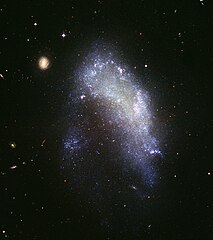NGC 1427A
| ||
 Galaktyka nieregularna NGC 1427A (HST) | ||
| Dane obserwacyjne (J2000) | ||
| Gwiazdozbiór | Erydan | |
| Typ | nieregularna (IBm) | |
| Rektascensja | 03h 40m 09,2s | |
| Deklinacja | –35° 37′ 24″ | |
| Odległość | 62 mln ly[1] | |
| Przesunięcie ku czerwieni | 0,006768[2] | |
| Jasność obserwowana | 12,8m | |
| Rozmiary kątowe | 2,3' × 1,5' | |
| Charakterystyka fizyczna | ||
| Wymiary | 20 tys. ly[3] | |
| Alternatywne oznaczenia | ||
| PGC 13500, ESO 358-49, MCG -6-9-16, AM 0338-354, FCC 235 | ||
NGC 1427A (również PGC 13500) – galaktyka nieregularna (IBm), znajdująca się w gwiazdozbiorze Erydanu w odległości około 62 milionów lat świetlnych. W tym rejonie nieba znajduje się także NGC 1427, obie te galaktyki należą do Gromady w Piecu[4].
NGC 1427A ma około 20 tysięcy lat świetlnych średnicy i jest podobna do Wielkiego Obłoku Magellana[3].
Galaktyka ta przedziera się przez ośrodek międzygalaktyczny Gromady w Piecu z prędkością około 600 km/s. Gaz należący do galaktyki zderza się z gazem międzygalaktycznym i ulega ściśnieniu tak dużemu, że w rezultacie prowadzi to do jego zapadania się pod wpływem własnej grawitacji i powstawania mnóstwa nowych gwiazd. W wyniku tego procesu NGC 1427A ma kształt grota strzały skierowanego w stronę, w którą galaktyka się przemieszcza. Siły pływowe pochodzące od sąsiednich galaktyk mogą również mieć wpływ na aktywność gwiazdotwórczą na tak wielką skalę. W ciągu następnych miliardów lat galaktyka ta ulegnie destrukcji, tracąc stopniowo gwiazdy i pozostały gaz[1][3].
Przypisy
- ↑ a b The Impending Destruction of NGC 1427A (ang.). W: HubbleSite [on-line]. Space Telescope Science Institute, 2005-03-03. [dostęp 2015-09-11].
- ↑ NGC 1427A w bazie SIMBAD (ang.)
- ↑ a b c NGC 1427A: Galaktyka w ruchu w serwisie APOD: Astronomiczne zdjęcie dnia
- ↑ Courtney Seligman: NGC 1427 (ang.). W: Celestial Atlas [on-line]. [dostęp 2015-09-11].
Linki zewnętrzne
- NGC 1427A w serwisie SEDS.org (Revised NGC and IC Catalog) (ang.)
- NGC 1427A w bazie SIMBAD (ang.)
- NGC 1427A w NASA/IPAC Extragalactic Database (ang.)
Media użyte na tej stronie
The irregular galaxy NGC 1427A will not survive long as an identifiable galaxy, passing through the Fornax cluster at nearly 600 kilometers per second (400 miles per second). Galaxy clusters, like the Fornax cluster, contain hundreds or even thousands of individual galaxies. Within the Fornax cluster, there is a considerable amount of gas lying between the galaxies. When the gas within NGC 1427A collides with the Fornax gas, it is compressed to the point that it starts to collapse under its own gravity. This leads to formation of the myriad of new stars seen across NGC 1427A, which give the galaxy an overall arrowhead shape that appears to point in the direction of the galaxy's high-velocity motion. The tidal forces of nearby galaxies in the cluster may also play a role in triggering star formation on such a massive scale.
